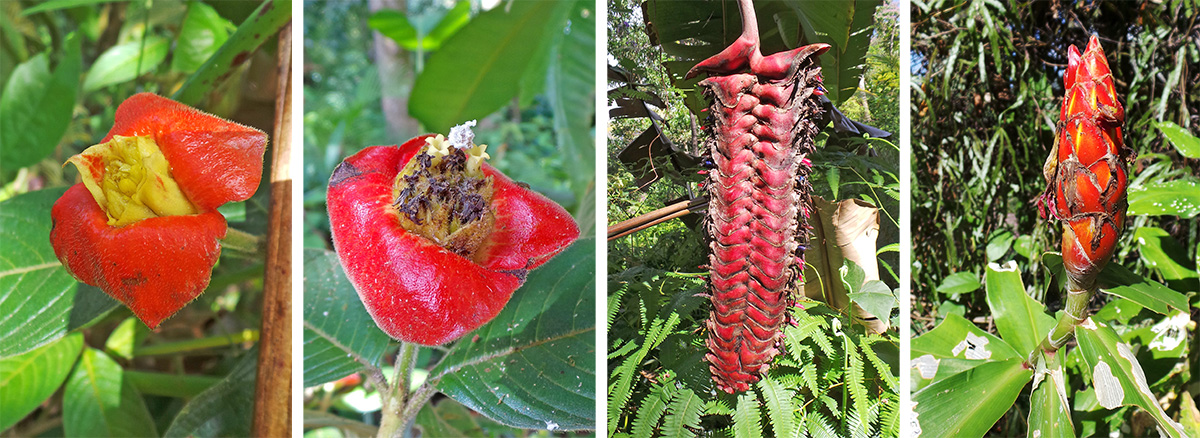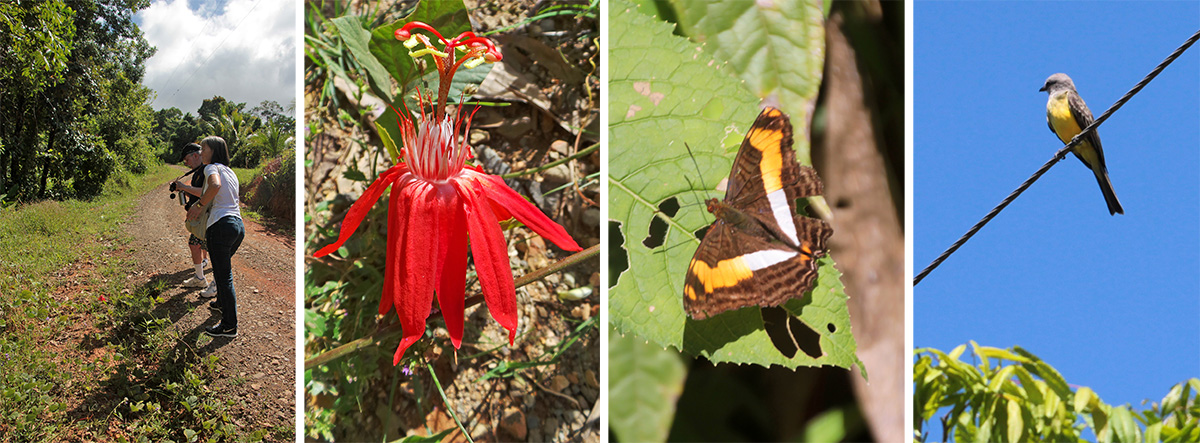The birds were singing before dawn, and the sun rose in clear skies, except for big fat clouds out over the water. Having arrived in the dark, the dramatic view over the dry forest filled with yellow-flowering trees stretching to the ocean was a surprise. It was 100 steps (plus some unpaved trails on more gentles slopes) from the lower rooms up to the open air bar/pool/dining area where we met for breakfast at 7:30. After enjoying fresh tropical fruit, pancakes, scrambled eggs, bacon, rice and beans and toast, people hung around the pool watching several black-mandibled toucans in the nearby cecropia trees.

View of the tropical dry forest and ocean from the pool area (L) and black-mandibled toucans in the nearby cecropia )trees (LC and RC) and flying away (R).
Today was a free day, so people could take optional tours, relax by the pool, read a book, or do nothing if they chose. Over half the group decided to take the optional mangrove tour in the afternoon. In the morning we did a leisurely walk along the dirt roads outside the hotel to look at the mostly native vegetation and any animals that might happen by. We saw lots of fan fern (Sticherus bifidus),

The group botanizing and birding along the road (L) and fan fern plants (LC), new foliage (RC) and tendril (R).
lots of different trees, with some in flower, the shrub Psychotria spp. commonly called hot lips for the shape of the bright red flower bracts, a heliconia with a wide, dark red pendant inflorescence, a spiral ginger (Costus spp.) with an orange-red, cone-shaped inflorescence at the end of its twisted stem, and various other blooming herbaceous plants.

A fresh inflorescence of Psychotria sp. (L) and an older one with white flowers (LC), red inflorescence of Heliconia (RC) and spiral ginger (R).

Further up the road, with nice views of the ocean (L) and blooming trees in yellow (Schizolobium parahyba) and pink (LC). Flowers of Emelia sp. (RC) and leaf-footed bug on a flower bud (R).
There were lots of different types of butterflies flitting about, but they weren’t cooperative about posing for pictures. We also saw a few birds, including a yellow caracara that flew over, several tropical kingbirds (a type of flycatcher with a yellow belly) perched on the wires that would periodically dive off to chase insects, turkey vultures soared on the air currents up high, and a bright red male summer tanager. We could hear a violaceous trogon calling and several hummingbirds squeaking nearby, but they never came out where we could see them.

Don and Della stop on roadside (L) to look at the flower of Passiflora vitifolia (LC). Butterfly, Adelphia sp. (RC). Tropical kingbird (R).
I didn’t go on the mangrove tour (having been on many before), but stayed behind to work, test out the pool, and photograph the sunset that the others missed since they didn’t return until well after dark.

The pool at Vista Ballena (L) and sunset from there (R).
Those who went on the mangrove excursion reported they had a great time and learned a lot about this interesting habitat with mangrove plants that belong to several different plant families and have different adaptations for dealing with unstable soil and the high salt concentration of the brackish water they inhabit. Photos courtesy of Lisa Seidmann.

Egrets and herons in the mangrove habitat.
In addition to the vegetation, they were really impressed by the sheer number of about 30 different kinds of birds including several kinds of egrets, herons, anhinga, whimbrels, magnificent frigatebird, white-necked puffbird, yellow-headed and crested caracaras, ringed kingfisher, red-lored parrot, osprey, common black hawk, and orange-chinned parakeet and the big moon that rose while they were heading back to shore.

Whimbrels (L), immature yellow-crowned night heron (C), and magnificent frigate birds overhead (R).

The mangrove tour guide shows Lori and others a mangrove seed (L). Later in the tour as the sun disappeared the moon rose over the hillside (C) to glow in the early evening sky (R).
